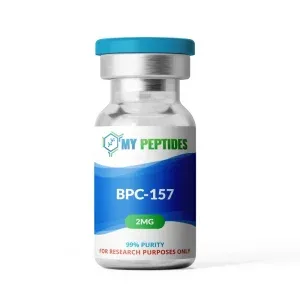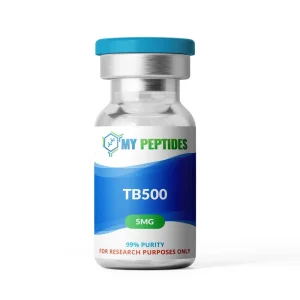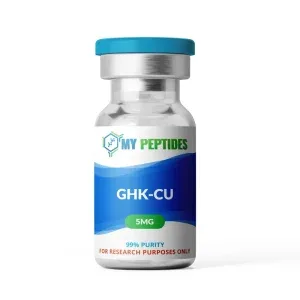Can BPC-157 Reduce Joint Pain?
Joint pain affects millions of people worldwide, also it creates daily challenges impacting mobility, range of motion, and quality of life.
Scientists study various compounds—including those linked to forms of arthritis like rheumatoid arthritis, psoriatic arthritis, and gout—so they can understand how inflammation is reduced and how damaged tissues are repaired by the body and immune system.
BPC-157 is one peptide about which attention has grown in studies. It is man-made and comes from proteins inside human stomach fluid.
This pentadecapeptide has been shown by multiple studies to have promising results in tissue repair, inflammation reduction, and even in cases of arthritis pain and stiffness.
It’s important to note that BPC-157 and all related peptides discussed here serve strictly for laboratory and research purposes only.
Explore BPC-157 from My Peptides, a research peptide derived from gastric proteins known for supporting tissue repair, inflammation control, vascular recovery, and improved joint studies—especially in inflammatory arthritis and other types of arthritis pain.

What Causes Joint Pain to Develop?
Joint pain develops through many pathways that researchers continue to study through laboratory settings. Age-related cartilage breakdown leads toward conditions like osteoarthritis, a form of arthritis.
With this condition, protective tissue wears away over a period of time. Sports or accident-related immediate damage may cause injuries, such as sprains or ligament tears, resulting in joint problems over the long term, even in the big toe or pelvis.
Joint structures may gradually wear down due to repetitive stress from work or daily activities causing reduced mobility, chronic discomfort, and sometimes severe pain and swelling.
Unexplained joint pain can also occur, prompting a physical exam, review of medical history, and blood tests such as a complete blood count to help determine the cause of joint pain.
Scientists design much better studies so as to test how compounds such as BPC-157 might address different types of joint damage, including those caused by bursitis, fibromyalgia, or systemic lupus erythematosus. They are able to do this by understanding these causes.
Laboratory investigations have shown that joint pain often involves multiple factors along with tissue damage, inflammatory responses, and reduced blood flow for affected areas.
How Does Inflammation Impact Joint Health?
Inflammation centrally develops into and progresses joint pain instead. Inflammatory responses are triggered by the body and immune system when tissues become damaged to protect as well as heal.
However, chronic inflammation, as seen in rheumatoid arthritis and psoriatic arthritis, is able to worsen joint pain in fact by damaging tissue and limiting the normal repair mechanisms.
BPC-157 possesses meaningful anti-inflammatory properties for the possibility of helping to reduce harmful inflammatory markers based upon laboratory studies. The compound seems to modulate inflammatory pathways, possibly reducing swelling, redness, soreness, and related discomfort.
For controlling inflammation, there exist better conditions in support of tissue repair, scientists have observed within studies, and this may then help in prevention of more joint damage in laboratory models.
What Makes BPC-157 Unique for Joint Studies?

Because of multiple mechanisms of action as well as stability in laboratory conditions, BPC-157 stands out among the research compounds.
BPC-157 is valuable for the studying of aspects related to healing and recovery processes, unlike many peptides, because it shows properties of both gastric protection and tissue repair.
Clinicians observe, gathering data of interest. BPC-157 does effectively address the joint pain, including pain from different types of arthritis.
Research shows that peptides ease the creation of new blood cells, help with wound healing, and possess anti-inflammatory properties since those properties support soft tissue repair and improved range of motion.
These findings are encouraging. Laboratory investigations are happening further to study the compound’s mechanisms, including its effects on ligaments and tendons.
The peptide is stable within consistently affected controlled environments. Scientists find it especially helpful for tissue repair and when studying joint pain mechanisms.
My Peptides offers BPC-157 in multiple formats as well as in pre-filled pens and vials. Nasal sprays for research uses are among these formats.
How Does Tissue Repair Function in Joint Recovery?
Tissue repair function in joint recovery happens through the complex biological processes that researchers continue to study through the laboratory settings. The body naturally produces signals so they can attract repair cells toward injury sites and stimulate new tissue growth.
However, these processes become less efficient because of age along with chronic inflammation or repeated injuries over a period of time. Learn more about BPC-157 here.
Laboratory studies show that BPC-157 stimulates collagen synthesis and promotes formation of new blood vessels in controlled environments. These mechanisms are essential for proper tissue healing and could explain why joint pain reduction occurs in laboratory models.
The compound appears to enhance the body’s natural repair signals while providing protective effects against further tissue damage and loss of full range of motion.
Understanding tissue repair helps researchers develop better approaches for studying joint pain interventions, including physical therapy, physical activity, and nutritional supplements. Scientists design experiments so as to test how enhanced repair might benefit joint health over extended periods.
Why Are Blood Vessels Critical for Joint Health?
Blood vessels happen to be critical for joint health since necessary nutrients as well as oxygen are provided for damaged tissues, helping them to properly heal.
Poor circulation slows recovery processes with active joint pain since it limits delivery of repair materials for affected areas. Scientists find that it is the case that better circulation improves successful tissue repair.
Research shows that the removing of waste products or inflammatory substances is something that is helped by an improved blood flow.
Studies in the laboratory show that some compounds can promote the formation of blood vessels, which is important for supporting joint health in various forms of arthritis.
This promotion may help joints receive better nutritional support during their repair. This improves circulation so conditions support faster healing plus potentially longer-lasting joint pain relief in controlled models.
My Peptides offers research-grade compounds with verified purity. Controlled laboratory settings enable proper study of circulation effects for researchers.
What Other Compounds Show Promise for Joint Studies?

Other compounds show promise in scientists’ research joint studies so they can better understand tissue repair mechanisms. TB-500 is also a research peptide, and properties that it has are different when compared to BPC-157.
These properties were demonstrated in the course of laboratory investigations. While BPC-157 protects the stomach as well as repairs tissue more, TB-500 recovers muscle more strongly along with improves flexibility and range of motion.
Known as Thymosin Beta-4, TB-500 assists in tissue repair because it reduces inflammatory responses slowing healing plus promotes cell migration toward injury sites. Since it betters the body’s own healing actions, the substance seems useful for examining muscle and tendon repair processes across a duration.
TB-500 could regenerate hair follicles based on lab work, and circulation improves, suggesting other uses past joint pain studies. Scientists often investigate just how different peptides might work in conjunction together.
These approaches combine with peptides because they address to various aspects of joint pain, including stiffness, numbness, and tenderness.
Explore TB-500 from My Peptides – designed to enhance recovery, flexibility, and soft tissue resilience.
How Does GHK-Cu Contribute to Combination Approaches?

GHK-Cu contributes toward combination approaches since peptide properties combine with copper ions so improved biological activity is created in laboratory settings.
This complex peptide of natural origin displays outstanding attributes within lab investigations of wound mending as tissues gradually renew. Scientists find that GHK-Cu stimulates collagen synthesis, also glycosaminoglycan synthesis, components important to have for joint tissue that is healthy.
GHK-Cu, laboratory investigations show, acts like powerful tissue protector with anti-inflammatory properties that may help reduce joint pain in controlled models. Oxidative damage seems under compound control. At the same time, it promotes growth of new blood vessels toward affected areas.
These mechanisms interest researchers studying joint pain along with tissue degeneration particularly. Research indicates that GHK-Cu levels decrease as people age. This decrease correlates with both a reduced tissue repair capacity in addition to an increased joint pain development.
Explore GHK-Cu from My Peptides – a regenerative peptide that promotes collagen production and revitalizes connective tissue.
How Does Aging Influence Joint Pain and Tissue Repair?
 Aging influences joint pain since the body’s tissue repair capacity reduces. As people age, the levels of compounds like GHK-Cu will decrease, which means more frequent joint discomfort along with a slower healing.
Aging influences joint pain since the body’s tissue repair capacity reduces. As people age, the levels of compounds like GHK-Cu will decrease, which means more frequent joint discomfort along with a slower healing.
Because of how older joints will often show many signs of tissue degeneration, they include more cartilage thinning and less flexible connective tissue. As time passes, injured areas mend slower plus joints ache more.
For the laboratory study of the effects of aging upon tissue repair mechanisms, the scientists use peptides like GHK-Cu, TB-500, and BPC-157. For supporting of these natural repair pathways that may help to maintain joint health, according to research as people do grow older.
To help labs focus on how aging and joint pain connect in controlled studies My Peptides supplies these peptides only for research use.
Why Are Tissue Repair Studies Important for Joint Pain?
Studying tissue repair is important for joint pain research because it helps scientists understand how to restore function with a reduction of discomfort in damaged joints.
Healthy joints exist when tissue repair works correctly. The occurrence of chronic pain is also less likely. Laboratory investigations study if BPC-157, TB-500, and GHK-Cu peptides can promote blood vessel creation, increase collagen building, and aid tissue restoration after harm or decay.
These studies let research teams test new ideas for joint pain management. They also allow them to see compounds supporting tissue healing best.
My Peptides provides high-purity research-only peptides inside vials, pens, also sprays. Labs are supported by these products since they have a want to further joint pain science through thorough tissue repair.
References:
[1] Brcic L, Brcic I, Staresinic M, Novinscak T, Sikiric P, Seiwerth S. Modulatory effect of gastric pentadecapeptide BPC 157 on angiogenesis in muscle and tendon healing. J Physiol Pharmacol. 2009 Dec;60 Suppl 7:191-6.
[2] Sikiric P, Seiwerth S, Rucman R, Kolenc D, et al. Brain-gut Axis and Pentadecapeptide BPC 157: Theoretical and Practical Implications. Curr Neuropharmacol. 2016;14(8):857-865.
[3] Bilic I, Zoricic I, Anic T, Separovic J, et al. Haloperidol-stomach lesions attenuation by pentadecapeptide BPC 157, omeprazole, bromocriptine, but not atropine, lansoprazole, pantoprazole, ranitidine, cimetidine and misoprostol in mice. Life Sci. 2001 Mar 9;68(16):1905-12.
[4] Xue XC, Wu YJ, Gao MT, Li WG, Zhao N, Wang ZL, Bao CJ, Yan Z, Zhang YQ. Protective effects of pentadecapeptide BPC 157 on gastric ulcer in rats. World J Gastroenterol. 2004 Apr 1;10(7):1032-6.
[5] Drmic D, Kolenc D, Ilic S, Bauk L, Sever M, Zenko Sever A, Luetic K, Suran J, Seiwerth S, Sikiric P. Celecoxib-induced gastrointestinal, liver and brain lesions in rats, counteraction by BPC 157 or L-arginine, aggravation by L-NAME. World J Gastroenterol. 2017 Aug 7;23(29):5304-5312.
[6] Boban Blagaic A, Turcic P, Blagaic V, Dubovecak M, Jelovac N, Zemba M, Radic B, Becejac T, Stancic Rokotov D, Sikiric P. Gastric pentadecapeptide BPC 157 counteracts morphine-induced analgesia in mice. J Physiol Pharmacol. 2009 Dec;60 Suppl 7:177-81. PMID: 20388962.
ALL PRODUCT INFORMATION AND ARTICLES ON THIS SITE ARE INTENDED FOR EDUCATIONAL PURPOSES ONLY.
DISCLAIMER: All products sold by My Peptides are strictly intended for research and laboratory use only. These items are not designed for human or animal use or consumption. They are not classified as drugs, food, cosmetics, or medicinal products and must not be mislabeled or misused as such. By purchasing from our website, buyers acknowledge and accept all risks associated with handling these materials. The information and articles provided on this website are purely for educational and informational purposes. Handling and usage of these products should be carried out exclusively by qualified professionals.







 Aging influences joint pain since the body’s tissue repair capacity reduces. As people age, the levels of compounds like GHK-Cu will decrease, which means more frequent joint discomfort along with a slower healing.
Aging influences joint pain since the body’s tissue repair capacity reduces. As people age, the levels of compounds like GHK-Cu will decrease, which means more frequent joint discomfort along with a slower healing.
